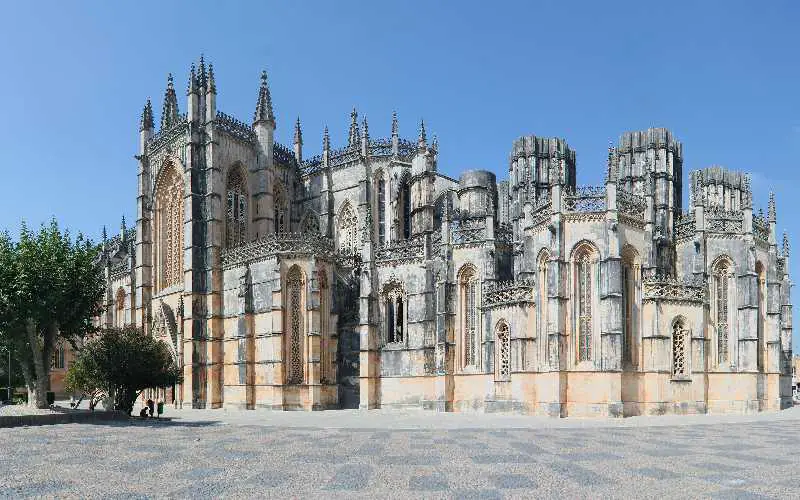One of the most famous places in the monastery Batalha is the unfinished chapel (Capelas imperfeitas in Portuguese). The last stage of the tour is a visit to the unfinished chapel at the back of the main church.
The Batalha Monastery can be enjoyed as a day trip from Lisbon or as a day trip from Porto. The hotel where I stayed, the Hotel Casa do Outeiro, has a room with a balcony overlooking the monastery and its church.
Batalha Monastery, a battle monastery in central Portugal, is one of the rare jewels of the UNESCO World Heritage Site that does not attract many visitors. It shows the skills of medieval Portuguese architects and stonemasons and has many unique features that are not seen anywhere else in the country. The reward for a relaxed exploration is that this is the kind of place you can stop for a short visit and find yourself a few hours later.
When re planning your visit to Batalha Monastery or Battle Monastery in central Portugal, we have everything you need to know about history, architecture, practical details and costs to make the most out of your visit.
The monastery of Batalha in Portugal is considered one of the country’s architectural masterpieces and a UNESCO World Heritage Site. The Batalhas Monastery is one of the best and most original examples of late Gothic architecture in Portugal, mixed with the Manueline style. Its Gothic structures are well preserved, and it is complemented by extras in this style.
The Batalha Monastery was built in 1385 due to the victory of Saint Mary in the Portuguese victory over the Castillians at the Battle of Aljubarrota, fulfilling the promise of Portuguese King John I.
Work began in 1386 by the Portuguese architect Afonso Domingue and lasted until 1402. He designed plans for many of the buildings, especially the church and cloister. His style was Rayonnant Gothic, influenced by the English Vertical Period.
The Portuguese Empire grew during the reign of seven kings (1386-1517) and money seemed to be the object of successive monarchs who wasted money on one of the best examples of Gothic architecture in Portugal. King Joao I never saw the Batalha completed, although the construction spanned all seven reigns.
The Dominican monastery of Batalha was built to commemorate the Portuguese victory over the Castilians at the Battle of Aljubarrota in 1385. It was to be the most important construction project of the Portuguese monarchies for the next two centuries. After 150 years of construction, it seems that King Joao III decided to concentrate on Jeronimos Monastery in Lisbon.
The Batalha Monastery (Mosteiro de Santa Maria da Vitoria de Batalhas) was founded in 1385 in gratitude for a great military victory and is a great example of medieval Portuguese architecture. The original national Gothic style developed under the influence of Manueline art, as evidenced by the Dominican monastery of Batalhas, a masterpiece of royal monasteries.
In 1385, after the victory of his outnumbered army over the Castilians in the important Battle of Aljubarrota, King Joao I vowed to build a magnificent monastery dedicated to the Virgin Mary. He won, which led to Portugal’s independence from Spain, and so the monastery was built.
King Joao I granted the Dominicans a magnificent monastery to a Virgin Mary, built in Gothic style and Manuelin style in the following two centuries. In order to fulfill the prayers of Mary after the victory, King John I ordered the construction of the Batalha Monastery. It is one of the most impressive religious buildings in Portugal.
Batalha Monastery is one of the most important examples of the Manueline architecture, a Portuguese style that developed during the Age of Discovery. It was commissioned in gratitude to King Joapso for his decisive victory in the Battle of Aljubarrota in 1385 by a magnificent design that took hundreds of years to build. Many architects had their hands in designing the buildings of the monastery, which is considered a precious Gothic treasure with different styles.
The Great Dominican Monastery of Santa Maria da Vitoria in the small town of Batalha in Central Portugal is not only a national sanctuary, but also one of the finest examples of Gothic architecture in Europe. From the valley floor rises the monastery with battlements and gargoyles that rise from windows, buttresses, balustrades and works of art in fine smooth limestone that sometimes turns into honey-colored gold as you gaze at the sunset. The Royal Cluster is one of the most prominent examples of the Manueline architecture of Batalha monasteries, a Portuguese style developed during the era of discovery.
The Mosteiro de Santa Maria da Vitoria (monastery of St Mary of Victory) is a UNESCO World Heritage Site in Leiria, central Portugal. It is a tower in the small town of Batalha. The monastery was built about two hundred years ago, between the 14th and the 16th centuries, to commemorate the Portuguese defeat of the Castilians in 1385 at the Battle of Aljubarrota.
The later Manueline additions to the original Gothic royal cloister are a special highlight, as is the Sala do Capitulo, a chapter room of the 15th century with beautiful stained glass windows.
If you enjoyed this article you might also like to read about Batalha Portugal



2 thoughts on “Batalha Monastery”